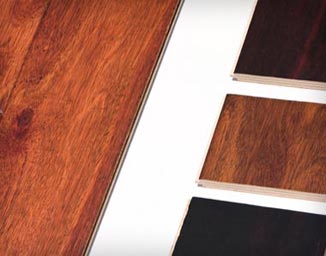
MasterCare offers a variety of hardwood flooring types to accommodate any space. The two primary types of flooring we use are solid and engineered. Which type is best for your project depends on a few factors.
During your installation or restoration consultation, a MasterCare craftsman will evaluate your space and current flooring. You’ll discuss your needs, style, and uses for the floors to determine the right type of flooring for your project.
With solid wood flooring, each strip or plank is cut entirely from one piece of solid wood. The advantages of this type is that it is available prefinished or unfinished and it can be sanded and refinished many times when in need of repair or a change in style.
Solid wood flooring is more susceptible to changes in moisture and temperature than other types. This means it will shrink, causing minor gaps in winter that will close back up in summer. This also means that it can be installed on or above grade/ground level, but not below where humidity levels rise.
Depending on the intended use of the floor and your aesthetic taste, you may choose:
Engineered Wood Flooring is created by adhering 3-12 thin layers of wood together to create strips or planks. Layers can be the same or different species where the top layer is the highest quality wood with the desired color and texture. Engineered wood can be sanded and refinished, but not as many times as solid wood.
The advantages of this type of flooring is that the grain of each layer runs in a different direction, making it very stable. It expands and contracts less than solid wood avoiding gapping and cracking. It can be installed above, on, or below grade/ground level.
Engineered wood comes in widths between 3” and 7” and a thickness of ⅜” – ¾”. This makes it available for any aesthetic.
When deciding on what type of flooring is best for your project, consider these factors:
Is your hardwood floor going to be installed at the ground level (on grade), on the second floor or above (above grade), or below the ground (below grade) like in a basement or sunken living room? Traditional, solid wood flooring is suitable only for on or above grade applications, as below grade is usually too damp. Engineered wood flooring is suitable for any location. Where the house or building is located can also affect your choice. Humid regions of the country are better suited to engineered wood.
Concrete subfloors require engineered wood flooring to ensure structural integrity. For plywood, existing wood floors, or OSB subfloors, either solid wood or engineered wood flooring will work best.
Once you determine the current conditions of your space, you can choose a hardwood flooring type to meet your needs. Contact us for an in-home or on-site consultation for help with this process and a free estimate.